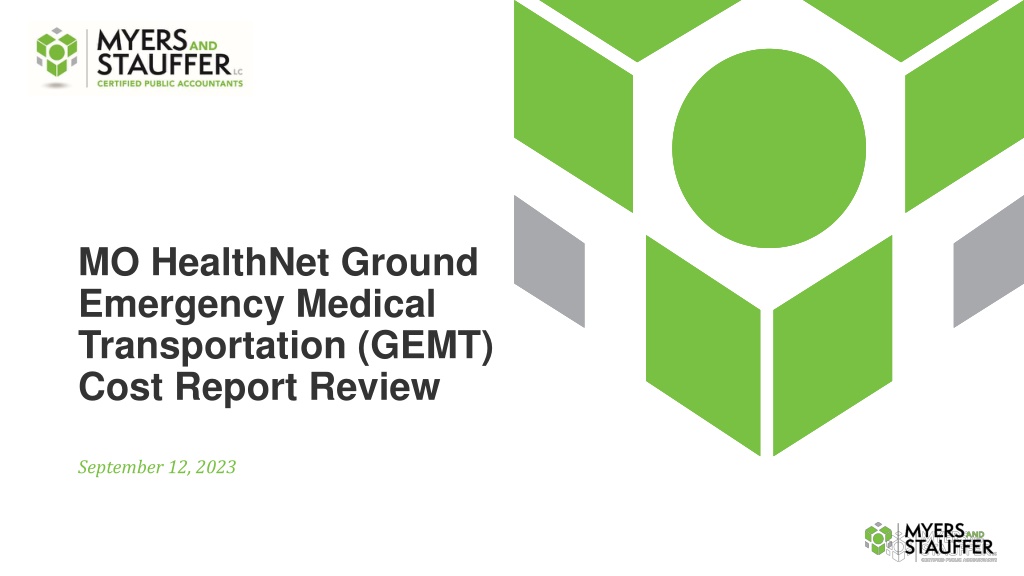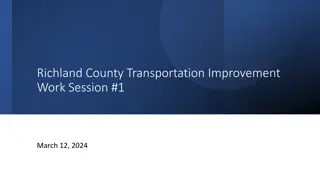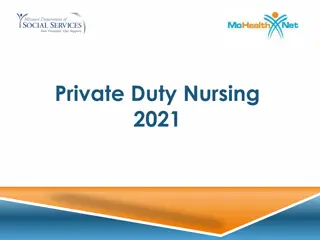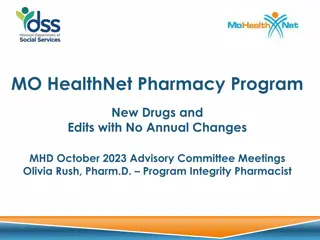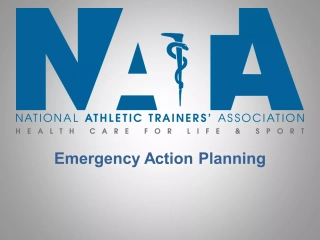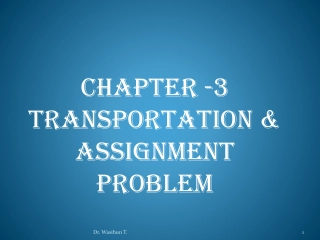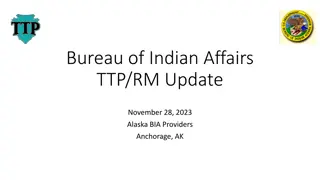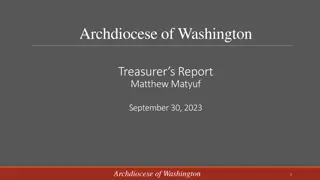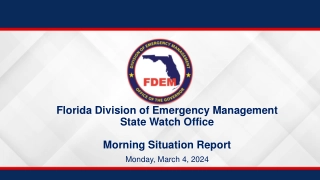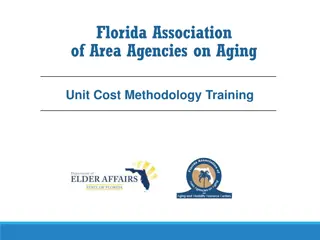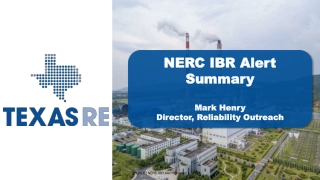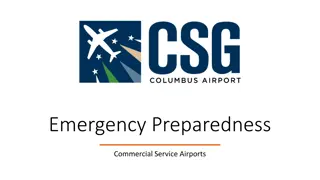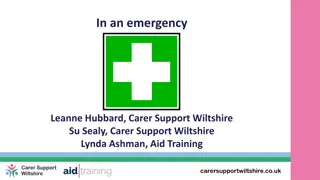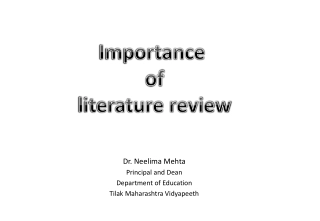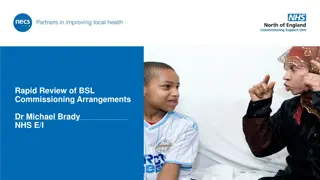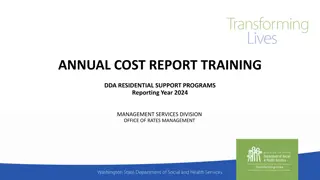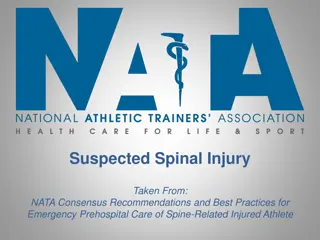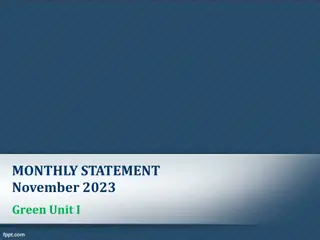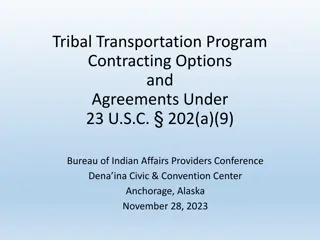MO HealthNet Ground Emergency Medical Transportation (GEMT) Cost Report Review Summary
The MO HealthNet Ground Emergency Medical Transportation (GEMT) Cost Report Review covers specifics of cost report schedules, common issues in certification, and details on emergency medical response expenses. The report highlights regulations, cost allocation challenges, and best practices for accurate reporting to avoid inquiries. Contact information for program policy contacts is provided for reference.
Download Presentation
Please find below an Image/Link to download the presentation.
The content on the website is provided AS IS for your information and personal use only. It may not be sold, licensed, or shared on other websites without obtaining consent from the author. Download presentation by click this link. If you encounter any issues during the download, it is possible that the publisher has removed the file from their server.
Presentation Transcript
MO HealthNet Ground Emergency Medical Transportation (GEMT) Cost Report Review September 12, 2023
INTRODUCTIONS Bob Hicks Managing Director Kaley Ingenthron Tevin Grace Manager Manager Contact Information PH: 1.800.374.6858 w FX: 816.945.5301 w MOGEMT@mslc.com w www.myersandstauffer.com
MO HEALTHNET PROGRAM POLICY CONTACTS Fatimah Jennings Connie Sutter Jamie Purnell Erica Peart Connie.M.Sutter@dss.mo.gov Jamie.Purnell@dss.mo.gov Fatimah.Jennings@dss.mo.gov Erica.Peart@dss.mo.gov Contact Information
Specifics of Cost Report Schedules
GENERAL INFORMATION AND CERTIFICATION Common Issues PDF of signed certification is not submitted. Question 21 regarding other entities providing ambulance services left blank. Questions 23 and/or 24 regarding ambulance billing services left blank. Best Practice Be sure to complete all requested fields to avoid requests/inquiries, and to submit PDF of signed page to avoid additional information requests/inquiries from accountants.
SCHEDULE 2 EMERGENCY MEDICAL RESPONSE EXPENSES Regulation Definition A cost objective that includes all expenditures for GEMT services. GEMT services are both the act of transporting an individual from any point of origin to the nearest medical facility capable of meeting the emergency medical needs of the patient, as well as the advanced, limited-advanced, and basic life support services provided to an individual by eligible GEMT providers before or during the act of transportation .GEMT services also include advanced, limited-advanced, and basic life support services provided to an individual who is released on the scene without transportation by ambulance to a medical facility. Eligible GEMT providers that do not provide fire services would not have costs on Schedules 4 and 5. The cost report would only reflect EMR direct costs.
SCHEDULE 2 EMERGENCY MEDICAL RESPONSE EXPENSES Common Issue Costs were reported as direct after an allocation statistic was used to manually calculate the split between EMR and non-EMR outside of the cost report. Example(s) Provider identified accounts in general ledger and applied a time-on-task ratio of 87% EMR and 13% non- EMR to accounts, then reported those splits on Schedules 2 and 3. Best Practice Report amounts from general ledger that include both EMR and non-EMR costs on Schedules 4 and 5 and allow cost report mechanics to perform direct cost allocation.
SCHEDULE 2 EMERGENCY MEDICAL RESPONSE EXPENSES Common Issue Amounts reported on the cost report did not reconcile to supporting documentation. Example(s) Several providers reported budgeted amounts. Best Practice Report actual costs incurred from the general ledger, working trial balance, and/or fund accounting report.
SCHEDULE 3 NON-EMERGENCY MEDICAL RESPONSE EXPENSES Regulation Definition A cost objective that includes expenditures for non- medical emergency services, such as fire suppression not including medical services, and non-emergency ancillary services, such as fire prevention and fire permit issuance that are performed in the absence of an emergency in order to support preparedness, mitigate the need for emergency response, or lessen the severity of an emergency that might occur.
SCHEDULE 3 NON-EMERGENCY MEDICAL RESPONSE EXPENSES Common Issue Costs that should be partially or fully allocated to EMR cost reported as non-EMR. Example(s) Salary for an administrative person who is responsible for billing ambulance services. The cost of dispatch services that dispatch both fire trucks and ambulances. Best Practice Costs such as personnel or overhead departments who perform EMR and non-EMR services should be allocated between EMR and non-EMR through Schedules 4 and 5.
SCHEDULE 4 ALLOCATION OF CAPITAL RELATED AND SALARIES & BENEFITS EXPENSES Regulation Definition Costs that cannot be directly assigned to EMR services or non-EMR services relatively easily with a high degree of accuracy. Examples of costs include personnel who perform EMR and non-EMR services and overhead departments who perform EMR and non-EMR services. These costs shall be allocated based on a reasonable method in accordance with the guidelines in 2 CFR, Part 200. Examples of reasonable allocation methods include: Square footage allocations for capital cost; Depreciation cost for capital cost; or Time studies for salaries and benefits.
SCHEDULE 4 ALLOCATION OF CAPITAL RELATED AND SALARIES & BENEFITS EXPENSES Common Issue Providers that provide both fire and ambulance services did not report any direct cost allocations. Example(s) It is possible firefighters who are licensed or certified emergency medical technicians spend some of their working hours on ambulance runs. Therefore, it is possible the salaries for licensed or certified firefighters and paramedics performing GEMT covered services should be reported on Schedule 4. Best Practice Salaries and fringe benefits associated with personnel providing Medicaid covered services at an emergency site should be reported as direct cost allocations, other than specific employees whose duties can be tied entirely to either ambulance or fire services.
SCHEDULE 4 ALLOCATION OF CAPITAL RELATED AND SALARIES & BENEFITS EXPENSES Common Issue Inadequate or unreasonable documentation provided for allocation statistics. Example(s) Inadequate narrative that lists number of EMR dispatches to non-EMR dispatches to support statistic. Unreasonable hours log that includes 100% of all firefighters non-PTO hours as EMR. Best Practice Adequate report or log that includes a record of all dispatches by type with dates that each dispatch occurred. Reasonable hours log that identifies the time spent by licensed or certified emergency medical technician providing Medicaid covered services at an emergency site.
SCHEDULE 5 ALLOCATION OF ADMINISTRATIVE & GENERAL Common Issue No costs reported on this schedule for dual fire/ambulance providers. Example(s) Plant operations and maintenance, utilities, dispatch services, etc. that benefit both EMR and non-EMR. Best Practice Administrative and General costs that are not segregated at the general ledger level should be allocated through Schedule 5.
SCHEDULE 5 ALLOCATION OF ADMINISTRATIVE & GENERAL Common Issue Capital expenditures, bond principal, and other large purchases/expenses for capital-related items reported as costs. Example(s) Provider reported capital purchase for a new ambulance as capital related costs. Provider reported bond principal on the cost report. Best Practice Capital expenditures fluctuate significantly from year to year, therefore, capital purchases should be capitalized, and depreciation expense reported each year. Interest and bond financing costs should be reported only.
ALLOCATION METHODOLOGIES FOR DIRECT COSTS Best Practice Allocation Methodologies Directly assigning costs based on general ledger detail Directly assigning salaries and fringe benefits utilizing payroll data/ledgers Calculated EMR/non-EMR percentage based on general ledger detail/payroll data (detailed support for the calculation must be provided) NOTE: By allowing the cost report mechanics to perform the direct and indirect cost allocations, there is a lesser burden on providers to manually calculate the split of costs between EMR and non-EMR, and less supporting documentation needed by the accountants to verify the costs reported.
CMCS INFORMATIONAL BULLETIN AUGUST 17, 2022 CMS Guidance CMS released guidance regarding the GEMT programs in which it discusses the treatment of fire costs on the cost report. Based on this guidance in the CIB, any personnel who is not considered a licensed or certified emergency medical technician and/or did not perform Medicaid covered services at an emergency site will be considered 100 percent fire, regardless if the personnel was dispatched for an EMS service. Best Practice In the allocation statistics, providers should clearly identify time associated with vehicle(s) or personnel not providing Medicaid covered emergency services. It is suggested to submit CAD data that includes the following data elements: Call number, dispatch date, each unit dispatched for the call, call disposition, call dispatch time, medical facility arrival time, call clear time, call duration, and classification of dispatch.
COMMON NON-ALLOWABLE COST ADJUSTMENTS Bad Debt Costs associated with bad debt or collection fees are considered non-allowable. 2 CFR Part 200.426 Board of Directors Costs associated with board of directors are considered non-allowable. 2 CFR Part 200.422 Capital Expenditures Asset purchases greater than $5,000 are considered capital expenditures and are non-allowable. Costs associated with the capital expenditures can be included in the cost report by including the depreciation expense. Depreciation expense should follow AHA guidelines. 42 CFR Section 413.130 2 CFR 200 CMS Pub. 15-1, Section 2300 CMS Pub. 15-1, Section 108.1
COMMON NON-ALLOWABLE COST ADJUSTMENTS FRA Tax Pooling and Administrative Fees and Pooling Payments The provider tax assessment expense, excluding administrative fees and pooling fees, paid to the state is an allowable expense. However, the provider tax assessment will be reduced by the pooling payments received from participation in the tax program. Income Offset Income from non-ambulance services (i.e. training revenue, dry run revenue, interest income) are to be offset against cost. CMS Pub. 15-1, Section 2328 Intergovernmental Transfer (IGT) of Funds The IGT of funds made to MHD are considered non-allowable. For instance, the IGT of the nonfederal share of the uncompensated Medicaid costs to receive the uncompensated Medicaid cost amount calculated on the cost report. MHD Administrative Costs Administrative costs incurred for reimbursing MHD for costs associated with implementing the GEMT program are considered non-allowable.
SCHEDULE 8 REVENUE/ FUNDING SOURCES Common Issue Medicaid revenues were adjusted to the most recent MMIS data. Example(s) Revenues reported varied from MMIS data due to timing differences, ability of providers to pull the necessary support from the system, etc. Considerations It is common across all provider types and Medicaid cost report engagements that this adjustment is made. Using more recent paid claims data helps ensure providers are reimbursed for Medicaid claims that were pending at the time of cost report filing.
SCHEDULE 8 REVENUE/ FUNDING SOURCES Common Issue Medicaid revenues were adjusted to include the enhanced rates from MoEMSAC. Example(s) Revenues reported varied from MMIS data due to enhanced rates being included in MMIS data. Considerations Using the paid claims data helps ensure providers include the enhanced rate revenues in Section A of Schedule 8.
SCHEDULE 9 SETTLEMENT CALCULATION Common Issue Medicaid transports were adjusted to the most recent MMIS data. Example(s) Transports reported varied from MMIS data due to timing differences, ability of providers to pull the necessary support from the system, etc. Considerations It is common across all provider types and Medicaid cost report engagements that this adjustment is made. Using more recent paid claims data helps ensure providers are reimbursed for Medicaid claims that were pending at the time of cost report filing.
SCHEDULE 9 SETTLEMENT CALCULATION Common Issue Total transports were adjusted to provider s support. Transport support was reviewed for dates of service, transport type, payers included (should be all), dry runs, etc. Example(s) Only emergency transports were reported. Only transports billed or paid during the year were reported. Treat, no transports were not reported. Best Practice Ensure that total transport log includes all transports that were dispatched during the cost report year, regardless of whether they were billed or paid, and regardless of the potential payer (Medicare, Medicaid, private insurance, patient, etc.) Review the log for potential errors, such as duplicates.
ISSUES TO CONSIDER Dry Runs Inter-Facility Transports Procedure codes A0426 and A0428 are considered inter-facility transports with an ambulance vehicle. These procedure codes are reimbursable under two programs: Ground emergency medical transportation (GEMT) Non-emergency medical transportation (NEMT) The current treatment of dry runs is: Include all dry run costs, less any revenues received for dry run services, in the cost report. Exclude dry run transports from Schedule 9. Currently, we are treating dry runs as an overhead expense that is a reasonable and expected cost of doing business as an ambulance provider. This could change in the future depending on CMS guidance. GEMT inter-facility transports are to be reported on Schedule 9 in total transports and the associated cost is allowable. NEMT inter-facility transports are not to be included in total transports on Schedule 9 and the associated cost is non-allowable. The cost associated with NEMT inter- facility transports should be identified and removed from the cost report. The current treatment of dry runs ensures that each payer (Medicare, Medicaid, private insurance) bears their share of the dry run costs providers incur through normal course of operations.
Project Timeline
GEMT PROJECT TIMELINE October 2023 MMIS data will be supplied to providers to utilize in their 2023 cost report. November 2023 2023 cost report and supporting documentation deadline. Providers are to retain all records related to the cost report for six (6) years following the submission. If as-filed cost report does not reflect any uncompensated Medicaid costs associated with GEMT services, the provider is not entitled to receive an interim payment and will not be responsible for any costs associated with implementing the GEMT program. Early 2024 2023 interim payment letters issued.
Myers and Stauffer Review Process
AGREED UPON PROCEDURES Procedures Expense comparison to the working trial balance; review of direct EMR expenses; cost allocation for indirect capital expense and indirect salaries benefits; reconciliation to MMIS data. Additional Documentation and Information Request Reviews will likely require additional documentation and information requests during the process. MMIS Data Transport data will be compared to the MMIS data which has been supplied by MHD. Reviews Reviews will go through three levels of internal review before being drafted. Review results will be sent to providers within 60 days of all of the following conditions being met: review process has begun, all relevant data has been received from the providers. Failure to respond timely to additional information requests and questions will delay the receipt of review results.
COST REPORT DRAFT PROCESS Draft Package The draft package will include a cover letter, adjusted cost report, adjustment report and a management representation letter. Draft Package Availability The draft package will be uploaded to the web portal for providers to download. An email notification will be sent indicating the availability and due date. Providers will have 60 days to review the initial results. If No Disagreements with Draft Adjustments and Draft Cost Report If there are no disagreements with the findings in the drafted cost report, then sign, date and return the management representation letter. The signed representation letter must be uploaded to the web portal. If Disagreements with Draft Adjustments and Draft Cost Report If there are any disagreements with the findings in the drafted cost report, submit a letter or e-mail detailing the concerns and issues. Include any additional supporting documentation regarding the issue. The letter and support can be uploaded to the web portal.
COST REPORT DRAFT PROCESS Revised Draft Package A revised draft package will be sent after any additional supporting documentation is incorporated. Revised Draft Package Availability The revised draft package will be uploaded to the web portal for providers to download. An email notification will be sent indicating the availability and due date. No Further Disagreements If there are no disagreements with the findings in the revised drafted cost report, then sign, date and return the management representation letter. The signed representation letter must be uploaded to the web portal. Further Disagreements If there are any disagreements with the findings in the revised drafted cost report, submit a letter or e-mail detailing the concerns and issues. Myers and Stauffer must be notified timely of further disagreements.
COST REPORT DRAFT PROCESS Final Cost Report Package A final cost report package will be sent to the provider after the signed management representation letter is received by Myers and Stauffer. The final cost report package will include a cover letter and the adjusted cost report. Final Cost Reports to MHD The MO HealthNet Division will receive a copy of each provider s final cost report and results. No Representation Letter If no signed management representation letter is received from the provider, the MO HealthNet Division will be notified indicating the provider refused to sign the representation letter.
Letter Communication
LETTER COMMUNICATION GEMT Cover Letter October 2023 Highlights the cost report and supporting documentation filing procedures, notification of MMIS availability, web portal instructions, and cost report review procedures. Interim Reimbursement Determination Letter Early 2024 Highlights the interim determination amount and IGT instructions. Provider Initial Results Cover Letter Sent at the completion of the agreed-upon procedures Highlights the results of the adjusted cost report, the impact of the drafted results, and instructions on how to respond to the draft results. Final Determination Letter Sent within 60 days of finalizing the cost report Highlights the final results of the adjusted GEMT cost report, providers appeal rights based on their recoupment or additional reimbursement status, and instructions on how to return the funds.
Cost Report Web Portal and Submission of Documentation
COST REPORT WEB PORTAL Accessed online via https://mocostreports.mslc.com All current providers should be registered. If a registration form is needed, please contact Myers and Stauffer. Identity is verified by IP address Utilized by Myers and Stauffer and providers for submissions, request, drafts and PHI data.
COST REPORT WEB PORTAL Provider contacts must complete the registration form. Must be signed by the commissioner, fire/paramedic chief or someone of similar authority.
SUBMISSION TIPS Reconcile Support Ensure all supporting documentation submitted reconciles to the cost report. Submit Quality Documentation Ensure documentation meets the stated requirements. Submit Support in Excel If possible, submit all supporting documentation in Excel. Utilize Web Portal Events Utilize the events listed on the web portal to ensure all requested supporting documentation has been submitted.
WEB PORTAL EVENT LINE CROSSWALK FOR REQUIRED DOCUMENTATION Supporting Documentation Needed Electronic (Excel) Copy of GEMT Cost Report PDF copy of signed certification from General Information and Certification schedule Copy of the Intergovernmental Transfer of Public Funds Agreement (if not provided in prior years) Copy of the Administration Fee Agreement (copy applicable to cost report period needed every year) Copy of the Provider Agreement (if not provided in prior years) Copy of the Electronic Funds Transfer (EFT) Authorization Agreement (if not provided in prior years) Web Portal Upload Line GEMT Cost Report Signed General Information and Certification Sch. Intergov'l Transfer of Public Funds Agreement (if submitted in prior years, mark "N/A") Administration Fee Agreement (copy applicable to cost report period needed every year) Provider Agreement (if submitted in prior years, mark "N/A") EFT Authorization Agreement (if submitted in prior years, mark "N/A")
WEB PORTAL EVENT LINE CROSSWALK FOR REQUIRED DOCUMENTATION Supporting Documentation Needed Working Trial Balance (WTB) used to complete cost report Web Portal Upload Line WTB If no WTB, submit fund accounting report, and any other schedules used to support expenses reported on the cost report. Grouping Schedules These are files that identify the cost report line/schedule that include each expense from the WTB or fund accounting report. Audited Financial Statements (AFS) Grouping Schedule If audited is not available, provide copies of reviewed or compiled financial statements. AFS is needed for all overlapping periods not submitted in previous years. AFS
WEB PORTAL EVENT LINE CROSSWALK FOR REQUIRED DOCUMENTATION Supporting Documentation Needed Location (account number) of MoEMSAC tax in WTB Support for breakdown of MoEMSAC amounts in WTB (administration fee, gross tax expense, etc.). Support can include statement from MoEMSAC. Location (account number) of the IGT transfer amount in WTB Detailed support for Schedule 4 square footage allocation statistics Web Portal Upload Line MoEMSAC Tax Support MoEMSAC Tax Support IGT Transfer Location Schedule 4 Square Footage Support Detailed support includes the source data used to calculate the percentages
WEB PORTAL EVENT LINE CROSSWALK FOR REQUIRED DOCUMENTATION Supporting Documentation Needed Detailed support for Schedule 4 hours logged allocation statistics Web Portal Upload Line Schedule 4 Hours Logged Support Detailed support includes the source data used to calculate the percentages. Support for Schedule 6 reclassifications Schedule 6 Reclassification Support Support includes source data such as WTB account numbers, and calculations. Support for Schedule 7 adjustments Schedule 7 Adjustment Support Support includes source data such as WTB account numbers, and calculations.
WEB PORTAL EVENT LINE CROSSWALK FOR REQUIRED DOCUMENTATION Supporting Documentation Needed Support for indirect costs reported on Schedule 9. This should include the calculations and financial records utilized to determine indirect cost amounts. Source document and any related calculations for Schedule 9 indirect cost factor rate Support for transports reported on Schedule 9 Support for transports not reported on Schedule 9 Support for dry runs Dry run revenues Web Portal Upload Line Indirect Cost Support Indirect Cost Factor Rate Ambulance Transport Patient Detail Ambulance Transport Patient Detail Ambulance Transport Patient Detail Dry Run Revenues/Cost Support
Kaley Ingenthron 800.374.6858 MOGEMT@mslc.com CONTACT US 700 W. 47th Street, Suite 1100 Kansas City, Missouri 64112 www.myersandstauffer.com
